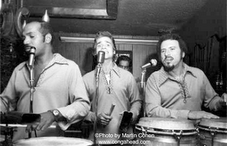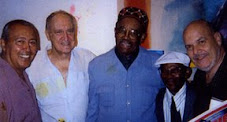 Letter to archivist Henry Medina
Letter to archivist Henry MedinaDear Henry:
Your interest in
Greenwich Village shows me that you are an artist at heart. With me, it was an accident of birth that placed me here, fortunately. I say fortunately because this is where I feel I most belong. If I could have had a choice, it would have been here or Paris, so much so that when I meet a Parisian, I feel I have much in common with him.
This is where I awoke from infancy when my mother took me to the window to show me snow in the backyard. My first view of “the world” was a beautiful one. Because the Ninth Ward (as Greenwich Village was once called, in the early 20th century) was so overrun with violence from street gangs, it was unsafe for me to play in the street. Furthermore, since we were landlords, there was much envy and hostility toward my family. I was only allowed out in the company of my grandmother or my uncle, on their daily visit to
St. Anthony’s Church (Shrine), that my grandfather was instrumental in establishing on Thompson Street. He hoped to help the community and at the same time increase property values in the neighborhood. Today, his dream is realized, I’m happy to say.
He admired and spoke often of the Germans, a more settled element in the city. “A walk in G.V.” referred to row houses north of Washington Square Park. These stately mansions were called, in my grandfather’s time and even today, the Rhinelander Estates (now owned by NYU). He had traveled all over Germany as his old passport shows, and was in the piano-string business at 5 Bedford Street, with a German family. He may very well have built the hurdy-gurdy organ that he’d carried around Europe as a musiker. He owned a stable and opened a bar to sell German beer. In those days, the Genoese families in the Village drank beer more than wine, since it was more readily available. When I was 9 or 10, I would go for beer for the men working on West Broadway (now Soho), bailing rags and paper. They called such young children “go-fors” in English, even though the men working the huge compacting machines were all Italian-Americans.
My father was a journalist, having been born in New York and having graduated high school. He began his newspaper career as Arthur Brisbane’s office boy and worked his way up to investigative reporter with the New York World and the New York American, both Hearst newspapers. He may also have worked at the old New York Evening Post (the editor was a certain Mr. Swope).
The Village at this time was very crowded with poor immigrant families. Walking to
PS 102, on Varick Street, I would be bullied, and sometimes spit on from tenants up at windows who identified me with my landlord family. Soon I was not allowed the natural pursuits of young kids and was kept tied to the fire escape. A cousin older than I would walk me up to Central Park and back, especially in the winter to ice skate on the lake. He would have to carry me home on his shoulders since it was quite far for me to walk. He would skate with me on his shoulders as well. His mother, my aunt Tessie, and my unmarried Uncle John, my grandparents, and my mom and dad were all obliged to live in the building. For safety, my dad moved me and Mom back to Brooklyn when I was 10 or 11. I had originally been born in Brooklyn, at a time when all the apartments in my grandfather’s building at 117 Sullivan Street were taken. As soon as a vacancy occurred, when I was 6 months old, my dad had us moved into my grandfather’s building, so I consider myself a Villager.
I remember what is now the Jefferson Market Courthouse Library, when it had a women’s prison attached to its property. That part was torn down around 1960, especially since the ladies would be yelling down from the barred windows at friends and passersby in the street and along Sixth Avenue. I played, jumping in the mountains of sand being excavated while they were building the Sixth Avenue subway, coming home all sandy. My real playground was
Washington Square Park, where I was taken daily after visiting Pompeii Church and St. Anthony’s, to ride my tricycle…the envy of the neighborhood kids whose families could not buy them one. We sat by
Garibaldi’s statue, since my father was a “Garibalino,” instrumental in raising money for the statue. He came to America in 1861 to join Garibaldi, who was living on Staten Island at that time, prior to leaving to fight in Peru against the Spaniards. He bought acres of empty land in Rego Park and Forest Hills but sold it in order to finance his son, Dominick (my uncle), who was running for mayor of Hoboken, where there was a very large community of Sicilians (who were being oppressed by the Irish political machine and made to work for a dollar a day paving streets). My uncle lost the election, and we became much poorer over time.
Today the rent for an apartment in what was my grandfather’s building on Sullivan Street is averaging $2,000 a month. Next to this building, I remember outhouses before there was central plumbing. The people called them “back houses,” as the historian Barry Lewis mentions. In Italian, “bacahows” or “cessos” (the second word comes from “cesspool” in English). Today you enter a tight alley to go into the backyard of the two buildings, where now there is a small cottage. This occurred in many instances where the space was used to build cottages where formerly there were crude toilets. Even as late as the 1960s there was a public toilet (men and women) around 17 Perry Street. Most of the kids were poisoned eating lead paint chips, as they still are today in poor neighborhoods in the Bronx and elsewhere in the city.
My mother loved dancing, and spoke of the cabaret named the
Black Cat (I think it was on West Third Street, in the 1920s).
Mori’s was the popular restaurant on West Fourth Street in 1945, which had a fountain in the interior yard. MacDougal Street was lined until just after the Second World War with private mansions with iron balconies and railings. The Provincetown Playhouse was there in 1946 through 1948, as was a nice club called Salle de Champagne, where guests sat on cushioned seats and drank champagne. A jazz spot named George’s was at the northeast corner, at 69 Bleeker Street and Seventh Avenue, and then, after the war, there was Louie’s on West Fourth and Barrow (today the One if by Land restaurant is located down the street).
In the hot summers when I was a child in the Village, horses would die in the streets, cops would shoot them, flies entered windows before screening, and recalling stable smells keeps me from liking horses to this day. I lit the gas lamps in the hallways of my grandpa’s building, while carried on my dad’s shoulders. The two communal toilets on each floor served three families and were the coolest places to escape the hot apartments. My dad bought me clothes on Orchard Street and, at 8 years old, I was always wearing a hat, which I took off to greet people as I bowed to them. My best friend was the son of the Jewish candy-store owner on Prince Street, when I was 9. My childhood in the Village was proper and not difficult compared to other kids, many of whom went to jail. Today, my Village is an abode of memories that will inhabit me forever.






